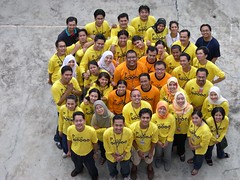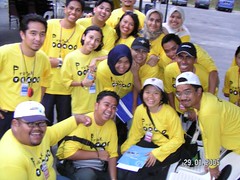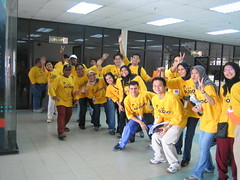Monday, December 22, 2008
Coach Aizan & Coach Azlan



Congratulations to Coach Aizan & Azlan!! This is the biggest TEKAD Wedding ever :D
The Akad Nikah was on Saturday, 20th December 2008. Let's all pray for their lifetime of happiness... :D
Labels: TEKAD Events and Happenings
TekadMon at 2:19 am
Saturday, July 05, 2008
Tekadmon Reached the Top!
Coach Fendi and his friends have proudly conquered Mount Trusmadi (the 2nd highest peak in Sabah!) and he did not forget to bring TEKAD with him ;)
Labels: Inspire
TekadMon at 12:03 am
Wednesday, March 12, 2008
SPM Results Are Out Today!!!
Dear Coaches,
Have you called or texted your champions to ask them about their SPM result? I bet some of our dear Champs are feeling very nervous and scared right now. I know I would be.
So please let them know that you're there for them no matter what the outcome of the result is. Let them know that it's not the end of the world if they fail. Be their sounding board.
Coaches, your champions need you today more than ever!
Have you called or texted your champions to ask them about their SPM result? I bet some of our dear Champs are feeling very nervous and scared right now. I know I would be.
So please let them know that you're there for them no matter what the outcome of the result is. Let them know that it's not the end of the world if they fail. Be their sounding board.
Coaches, your champions need you today more than ever!
Champions, we are here for you! Good luck!
TekadMon at 11:10 am
Tuesday, March 04, 2008
TEKAD Kelantan Gathering
TEKAD KELANTAN GATHERING
Venue: A&W KB Mall
Date: 24th December 2007
A total of 14 TEKAD Kelantan Champions came for the gathering with Coach Aizan and Coach Asma at A&W KB Mall on 24th December 2007! It was a time for catching up, not only for coaches with the champs, but also the champs with each other. All the champs looked very happy and relieve that SPM is over. Yeah, we remember that feeling.
It was great fun at the gathering and hopefully we’ll have more of this event to ensure we maintain the closeness in the TEKAD family. Maybe we could have the champs themselves to organize the next one...
So here are some pics for the album:
Venue: A&W KB Mall
Date: 24th December 2007
A total of 14 TEKAD Kelantan Champions came for the gathering with Coach Aizan and Coach Asma at A&W KB Mall on 24th December 2007! It was a time for catching up, not only for coaches with the champs, but also the champs with each other. All the champs looked very happy and relieve that SPM is over. Yeah, we remember that feeling.
It was great fun at the gathering and hopefully we’ll have more of this event to ensure we maintain the closeness in the TEKAD family. Maybe we could have the champs themselves to organize the next one...
So here are some pics for the album:

Labels: TEKAD Events and Happenings
TekadMon at 3:45 pm
Monday, January 21, 2008
The Tipping Point - Malcolm Gladwell
 The best way to understand the emergence of fashion trends, the ebb and flow of crime waves, the transformation of unknown books into bestsellers, the rise of teenage smoking, the phenomena of word-of-mouth, or any number of the other mysterious changes that mark everyday life is to view them as epidemics.
The best way to understand the emergence of fashion trends, the ebb and flow of crime waves, the transformation of unknown books into bestsellers, the rise of teenage smoking, the phenomena of word-of-mouth, or any number of the other mysterious changes that mark everyday life is to view them as epidemics.Ideas, messages and behaviors spread just like viruses do. These often spread like outbreaks of infectious disease. Just as a single sick person can start an epidemic of flu, so too can a few fare-beaters and graffiti artist fuel a subway crime wave, or a satisfied customer fill the empty tables of a new restaurant. These are social epidemics. The moment they take off, when they reach their critical mass, is the Tipping Point. The Tipping Point is one dramatic moment in an epidemic when everything can change all at once.
Epidemics have three characteristics:
1. contagiousness
2. little causes that can have big effects
3. change happens not gradually but at one dramatic moment
All epidemics have Tipping Points. The world of a Tipping Point is a place where the unexpected becomes expected, where radical change is more than possibility. It is contrary to all our expectations, it is a certainty.
Chapter 1: The Three Rules of Epidemics
Epidemics are a function of:
1. the people who transmit infectious agents
2. the infectious agent itself
3. the environment in which the infectious agent is operating
One critical factor in epidemics is the nature of the messenger. The message itself is something that can be passed on and tip simply if associated with a particular kind of person. The Law of the Few suggests that what we think of as inner states – preferences and emotions are powerfully and imperceptibly influenced by seemingly inconsequential personal influences.
In epidemics, the content of the message matters too. The Stickiness Factor is the specific quality of the message, food, or movie, or product that makes them "sticky" or memorable.
The power of Context says that human beings are a lot more sensitive to their environment than they may seem.
Chapter 2: The Law of the Few
Success of any kind of social epidemic is heavily dependent on the involvement of people with a rare set of social gifts. The Law of The Few says that there are exceptional people out there who are capable of starting social epidemics, and can make it tip.
Three kinds of people that control word-of-mouth epidemics are:
1. Connectors – the social glue who spread the message
2. Mavens – the databank who provides the message
3. Salesmen – the select group of people who have the skills to persuade people unconvinced of what they hear
Connectors are people with a special gift for bringing the world together. Word-of-mouth epidemics are the work of Connectors. They know lots of people and are at the center of events. They can be reached in only a few steps because they occupy many different worlds, subcultures and niches. We rely on them to give us access to opportunities and worlds to which we don't belong. Their ability to span many different worlds is a function of something intrinsic to their personality. Connectors have instinct that helps them relate to the people they meet. They simply like people in a genuine and powerful way. They collect people the same way others collect stamps. They see the possibility of being acquainted with anyone while most of us are busy choosing whom we would like to know.
Mavens are the ones who accumulates knowledge, and who is happy to pass it around. A Maven is usually not a persuader. Mavens are persons with information on a lot of different products or prices or places. They connect people to the marketplace and have the inside scoop. Mavens are socially motivated.
Salesmen are charismatic people that can infect others with their emotions without saying anything and with the briefest of exposures. It takes more than eloquence to make someone so persuasive. One must have the ability to draw others into his rhythms and dictate the terms of the interaction, ability to conduct conversation on his terms and the ability to create synchrony.
Chapter 3: The Stickiness Factor
The information age has created a "stickiness" problem. We simply don't remember much of what we are told or read or watched. But, there are simple ways to enhance and engineer stickiness into a message.
Chapter 4: The Power of Context
Epidemics are sensitive to the conditions and circumstances of the times and places in which they occur. The Power of Context says that we are more than sensitive to changes in context and the kind of contextual changes that are capable of tipping an epidemic are very different than we might ordinarily suspect. The Power of Context says that what really matters are little things. It says that you don't have to solve the big problems to solve crime. The shooting incident on the subway had very little to do with the psychological pathology as well as with their background and poverty. It has everything to do with the message sent by the graffiti on the walls and the disorder at the turnstiles.
The essence of the Power of Context is that our inner states are the results of our outer circumstances. Context matters. The specific and relatively small elements in the environment can serve as Tipping Points. Environmental Tipping Points are things that we can change. We can clean up graffiti and change the signals that invite crime in the first place. Crime can be more than understood, it can be prevented.
The Power of Context says that children are powerfully shaped by their external environment. The features of our immediate physical and social world – the streets we walked down, the people we encounter – all play a huge role in shaping who we are and how we act. In the end it isn't just serious criminal behavior that is sensitive to environmental cues, it is all behavior. It is possible to be a better person on a clean street or in a clean subway than in one littered with trash and graffiti.
The Magic Number One Hundred and Fifty suggests that the size of the group is one of those subtle contextual factors that can make a big difference. If we want groups to serve as incubators for contagious messages, then we have to keep groups below the 150 Tipping Point. Above that point, there will be structural impediments to the ability of the group to agree and act with one voice. Once the Tipping Point is crossed, group members begin to behave very differently as they become divided and alienated.
The paradox of epidemic is that in order to create one contagious movement you often have to create many small movements first.
Chapter 6: Case Study
Rumors, Sneakers and the Power of Translation
Why did Airwalk tip? Airwalk tipped primarily because its advertising was founded explicitly on the principles of epidemic transmission. The advertising company used dramatic images. The advertising firm served as Connectors, Mavens and Salesmen for Airwalk who simply take ideas and the information from a highly specialized world and translate them into language the rest of us can understand. To make an idea contagious, they alter it in such a way that extraneous details are dropped and others are exaggerated so that the message itself comes to acquire a deeper meaning.
Chapter 7: Case Study
Suicide, Smoking, and the Search for the Unsticky Cigarette
Studies suggest that suicide can be contagious. Suicide stories are a kind of natural advertisement for a particular response to your problems. The death of people in highly publicized suicides gave others "permission" to die – serves as Tipping Point in suicide epidemics.
Smoking epidemics begin in precisely the same way. The teen smoking epidemic is also a good illustration of the Stickiness Factor. The smoking experience is so memorable and powerful for some people that they cannot stop smoking. The habit sticks.
Chapter 8: Conclusion: Focus, Test and Believe
Tipping Points Lessons
First Lesson: Starting epidemics requires concentrating resources on a few key areas. The Law of the Few says that Connectors, Mavens and Salesmen are responsible for starting word-of-mouth epidemics. Your resources therefore, should be concentrated on these three groups. No one else matters.
The theory of Tipping Point requires that we reframe the way we think about the world.
Second Lesson: The world, as much as we want to, does not accord with our intuition. Those who are successful at creating social epidemics do not just do what they think is right. They deliberately test their intuitions.
Third Lesson: What must underlie successful epidemics is a bedrock belief that change is possible – that people can radically transform their behavior or beliefs in the face of the right kind of impetus. This contradicts some of the most ingrained assumptions we hold about ourselves and each other.
Fourth Lesson: We are actually powerfully influenced by our surroundings. Complex behaviors like smoking, suicide or crime show that we are suggestible in the face of what we see and hear, and that we are acutely sensitive to even the smallest details of everyday life.
By manipulating the size of a group, we can dramatically improve its receptivity to new ideas. By tinkering with the presentation of information we can significantly improve the stickiness. By finding and reaching those few special people who hold so much social power, we can engineer the course of social epidemics. Tipping Point reaffirms the potential for change and the power of intelligent action. The world may seem immovable, implacable place, but it is not. With the slightest push – in just the right place – it can be tipped.
© Petroliam Nasional Berhad. 2008.
Labels: TEKAD Books and Movies
TekadMon at 12:23 pm







